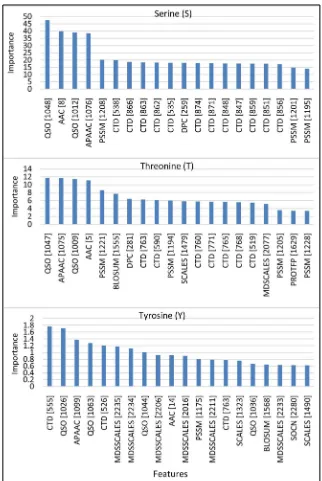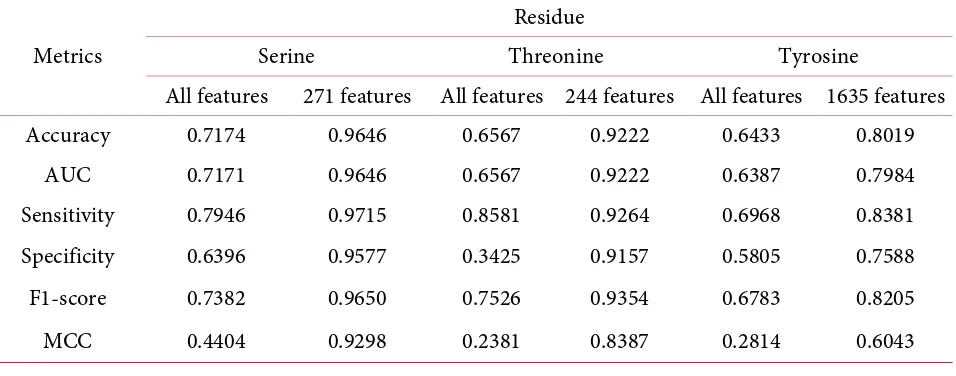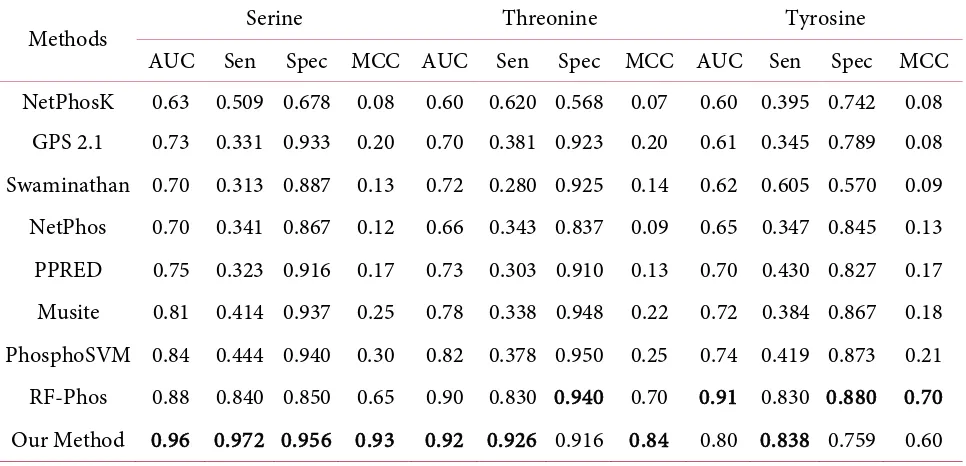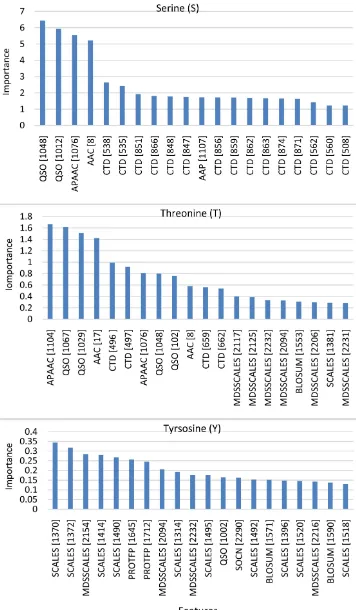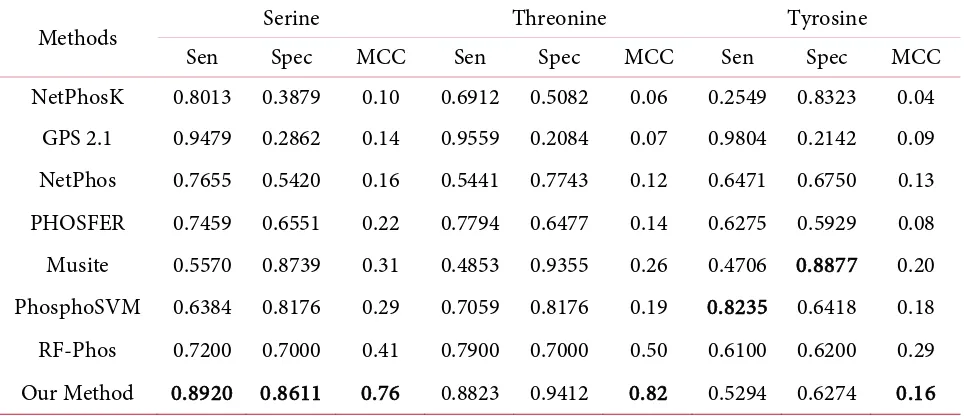http://www.scirp.org/journal/jbise J. Biomedical Science and Engineering, 2018, Vol. 11, (No. 6), pp: 144-157
https://doi.org/10.4236/jbise.2018.116013 144 J. Biomedical Science and Engineering
Improved Protein Phosphorylation Site Prediction by a
New Combination of Feature Set and Feature Selection
Favorisen Rosyking Lumbanraja1, Ngoc Giang Nguyen1, Dau Phan1, Mohammad Reza Faisal1, Bahriddin Abapihi1, Bedy Purnama1, Mera Kartika Delimayanti1, Mamoru Kubo2, Kenji Satou2
1Graduate School of Natural Science and Technology, Kanazawa University, Kanazawa, Japan; 2Institute of Science
and Engineering, Kanazawa University, Kanazawa, Japan
Correspondence to: Favorisen Rosyking Lumbanraja, ; Ngoc Giang Nguyen,
; Dau Phan, ; Mohammad Reza Faisal, ;
Bahriddin Abapihi, ; Bedy Purnama, ;
Mera Kartika Delimayanti, ; Mamoru Kubo, ;
Kenji Satou,
Keywords: Protein Phosphorylation, Phosphorylation Site Prediction, Sequence Feature, Feature Selection with Grid Search
Received: May 27, 2018 Accepted: June 26, 2018 Published: June 29, 2018 Copyright © 2018 by authors and Scientific Research Publishing Inc.
This work is licensed under the Creative Commons Attribution International License (CC BY 4.0).
http://creativecommons.org/licenses/by/4.0/
ABSTRACT
Phosphorylation of protein is an important post-translational modification that enables ac-tivation of various enzymes and receptors included in signaling pathways. To reduce the cost of identifying phosphorylation site by laborious experiments, computational prediction of it has been actively studied. In this study, by adopting a new set of features and applying feature selection by Random Forest with grid search before training by Support Vector Machine, our method achieved better or comparable performance of phosphorylation site prediction for two different data sets.
1. INTRODUCTION
Phosphorylation is one of the most important post-translational modifications (PTMs) in euka-ryotes. This occurs when a phosphate group is added to a protein by a kinase. The addition of phosphate group usually happens to Serine (S), Threonine, and Tyrosine (Y) [1]. It is also the common PTM, which occur in eukaryotic cell [2]. Between 30% and 50% proteins of eukaryotic cell undergo phosphorylation [3].
In the past, experimental approach such as mass spectrometry (MS/MS) [4] has been commonly used to identify phosphorylation sites. However, implementing this approach has several disadvantages. Con-ducting experiment to predict phosphorylation sites is considered expensive and requires intensive labor.
https://doi.org/10.4236/jbise.2018.116013 145 J. Biomedical Science and Engineering
In addition, it also requires adequate technique, skill, and specific equipment.
Instead, computational approach (in silico) is becoming more common because of new computer technology development. These days, computers can process large number of data in a short time. This makes prediction of phosphorylation sites using computational approach becoming more popular. Trost and Kusalik provided summarization of various technique approach, data, and tools that can be applied to predict phosphorylation site using computational approach [5].
In general, phosphorylation site prediction can be classified into two approaches: kinase-specific phosphorylation site prediction and non-kinase-specific (general) phosphorylation site prediction. Ki-nase-specific prediction approach requires both protein sequence and the type of kinase for phosphoryla-tion to conduct predicphosphoryla-tion. The other approach is non-kinaspecific, which only requires protein se-quence. Xue and Trost provided comparisons of these two approaches [5, 6]. The main disadvantage of kinase-specific approach is that the publicly available information about the type of kinase is limited, espe-cially for human kinase [7]. Therefore, non-kinase-specific approach is more popular to predict phospho-rylation site [8].
There are various methods proposed for the prediction. For example, Blom used neural network (NN) approach to predict eukaryotic protein phosphorylation site based on sequence and structure of proteins [9]. Kim proposed a prediction method using support vector machine (SVM) [10].
In this paper, we propose a new prediction method for non-kinase-specific phosphorylation site. By adopting a new combination of a classifier, features, and feature selection algorithm, we improved the performance of prediction. We measured the result of feature selection and classification and compared it with existing methods. We also tested our method with an independent data set and analysis of the classi-fication result.
2. MATERIALS AND METHODS
2.1. Data Sets
In this work, we followed the preparation step done by Ismail [11]. The dataset we use were down-loaded from the Phospho SVM website [12]. The phosphorylation site data set is P.ELM version 9 [13]. The data set contains phosphorylated sequences at the position of Serine (S), Threonine (T), and Tyrosine (Y). These sequences were also checked for redundancy and sequences that had similarity more than 30% were removed. Table 1 shows the number of sequences and number of sites for Serine, Threonine, and Tyrosine, respectively.
We generated fixed-length protein sequences using window size 9, which have phospholyratable re-sidues (Serine, Threonine, or Tyrosine) at the center of them. If the center residue of the sequence is known as phosphorylated, the sequence is “positive”, otherwise “negative”. For positive and negative se-quences, redundant ones were removed using skipredundant [14]. The parameters for redundancy remov-al are as follows: acceptable threshold percentage of similarity was set to 0% - 20%, vremov-alue for gap opening penalty to 10, and gap extension penalty to 0.5. Table 2 shows the number of positive and negative se-quences before and after removing redundant sese-quences for each residue.
The number of negative sequences after redundancy removal for Serine, Threonine, and Tyrosine re-sidues are: 4771, 3343, and 898, respectively. We then randomly selected negative sequences for each resi-due with the same number of negative sequences in the work of Ismail.
https://doi.org/10.4236/jbise.2018.116013 146 J. Biomedical Science and Engineering
Table 1. P.ELM data set of phosphorylation site from PhosphoSVM website.
Residue Number of Sequence Number of Sites
Serine 6635 20,964
Threonine 3227 5685
Tyrosine 1392 2163
Table 2. Number of sequences before and after removing redundant sequence for window size = 9.
Residue Positive Negative
Before After
Serine 20,557 1554 1543
Threonine 5596 707 453
Tyrosine 1392 267 226
Table 3. PPA data set as the independent data set.
Residue Number of positive/negative sequences after redundancy removal
Number of positive/negative sequences after selection
Serine 484/1830 307/307
Threonine 132/1227 68/68
Tyrosine 187/640 51/51
2.2. Methods
2.2.1. Feature Extraction
Using the fixed-length sequences, we conducted feature extraction to represent them as vectors of numerical values. We used three different programs to extract features: PROFEAT (2016), PSI-BLAST, and protr.
PROFEAT (2016) is a web server for extracting features from protein sequences [16]. We used it to generate the following feaures: Amino Acid Composition, Dipeptide Composition, Normalized Mo-reau-Broto Autocorrelation Descriptor, Moran Autocorrelation Descriptor, Moran Autocorrelation De-scriptor, Geary Autocorrelation DeDe-scriptor, Composition, Transition, Distribution DeDe-scriptor, Amphi-philic Pseudo-Amino Acid Composition, and Total Amino Acid Properties. For Position Specific Scoring Matrix (PSSM) features, we used PSI-BLAST [17]. In addition, an R package called protrwas used to pro-duce the following features: BLOSUM and PAM Matrices for the 20 Amino Acid, Amino Acid Properties Based Scales Descriptor (Protein Fingerprint), Scales-based Descriptor derived by Principal Components Analysis, Scales-based Descriptor derived by Multidimensional Scaling, Conjoint Triad Descriptors, and Sequence-Order-Coupling Number [18]. Details of these features are described below. Except three fea-tures (CTD, SOCN, QSO), most of the feafea-tures are not used in Ismail’s work.
Amino Acid Composition (AAC)
Amino Acid Composition is defined as the fraction of each amino acid in a protein sequence [19]. For all 20 amino acids, the fraction is calculated using this equation.
total of number of amino acid type fraction of
total number of amino acid in protein sequence
i
i
https://doi.org/10.4236/jbise.2018.116013 147 J. Biomedical Science and Engineering
where i is a spesific type of amino acid
Dipeptide Composition (DPC)
Dipeptide Composition generates 400 fixed-length numeric information based on the input protein sequences. It encapsulates information about the fraction of amino acid as well as their local order. It is calculated using Equation (2):
( )
total of number of( )
fraction of
total number of all posible dipeptide
dep i
dep i = (2)
where dep(i) is one dipeptide i of 400 dipeptides.
Normalized Moreau-Broto Autocorrelation Descriptors (NMB)
Before we calculate Normalized Moreau-Broto Autocorrelation, we must define Moreau-Broto Au-tocorrelation. It can be define using Equation (3):
( )
1reau-Broto Autocorrelation is defined using Equation (4) [20]:
( )
AC d( )
When we usePROFEAT, the value of nlag should be lower than the size of the sequence. Since the window size is 9, we setnlag = 8.
Moran Autocorrelation Descriptors (MORAN)
Moran Autocorrelation can be calculated using Equation (5):
( )
(
)(
)
Geary Autocorrelation Descriptors (GEARY)
Geary Autocorrelation can be defined using Equation (6):
( )
(
)
(
)
Composition, Transition, Distribution (CTD)
Composition, Transition, Distribution represent the amino acid distribution patterns of a certain structural or physicochemical property from a protein sequences. These features are calculated as follows: the protein sequence is transformed into a sequence of a specific physicochemical or structural properties of residue. Twenty amino acids are divided into three groups [20, 21].
Composition (C), Transition (T), and Distribution (D) are then calculated for a given attribute to de-scribe the global percent composition if the three groups of amino acids in a protein, the percent frequen-cies with which the attribute changes its index along the entire length of the protein, and the distribution pattern of attribute along the sequence, respectively.
Sequence-Order-Coupling Number (SOCN)
num-https://doi.org/10.4236/jbise.2018.116013 148 J. Biomedical Science and Engineering
ber can be calculated using Equation (7):
(
,)
Quasi-Sequence-Order Descriptors (QSO)
Quasi-Sequence-Order Descriptors can be calculated using Sequence-Order-Coupling Number. For each amino acid type, the type-1 Quasi-Sequence-Order Descriptors is calculated using Equation (8):
20 30
type-2 Quasi-Sequence-Order Descriptors is calculated using Equation (9):
20
Amphiphilic Pseudo-Amino Acid Composition(APAAC)
Before we calculate Amphiphilic Pseudo-Amino Acid Composition, we must define Pseudo-Amino Acid Composition (PAAC) [22]. First, three variables are generated from the original hydrophobicity val-ues H10
( )
i , hydrophilicity values H20( )
i , and side chain masses M0( )
i of 20 amino acids (i = 1, 2, 3, ∙∙∙,Then, a correlation function can generated as:
https://doi.org/10.4236/jbise.2018.116013 149 J. Biomedical Science and Engineering
From which, sequence order-correlated factors are defined as:
(
) (
)
where λ is parameter. Let fi be the normalized frequency of 20 amino acids in the protein sequence, a set of
20 + λ descriptors called the PAAC can be defined using Equation (15):
20
where w = 0.05. From Equation (10) and Equation (11), the hydrophobicity and hydrophilicity correlation can be define as:
Then, sequence order factor can be define using Equation (17):
2 1 1 2
Finally, APAAC can be calculated using Equation (18):
20 2
Total Amino Acid Properties (AAP)
Total Amino Acid Properties for a specific physicochemical property i is defined using Equation (19):
( ) 1
of the protein sequence. i j
norm
P is calculated using Equation (20):
min maximum values of the original amino acid property i, respectively.
Position Specific Scoring Matrix (PSSM)
PSSM features were generated using PSI-BLAST against a local database generated from the phos-phorylation data set.
BLOSUM and PAM Matrices for the 20 Amino Acid (BLOSUM)
In the use of protr, we setk = 5, lag = 3, and Matrix type = AABLOSUM45.
Amino Acid Properties Based Scales Descriptor (Protein Fingerprint) (ProtFP)
In the use of protr, we set pc = 5, lag = 5, index vector for Amino Acid Index = (160:165, 258:296).
Scales-based Descriptor derived by Principal Components Analysis (SCALES) In the use of protr, we set pc = 7, lag = 5, properties matrix = AA index (7:26).
https://doi.org/10.4236/jbise.2018.116013 150 J. Biomedical Science and Engineering
Conjoint Triad Descriptors (CTriad) [22]
2.2.2. Feature Selection
Random Forest was introduced by Breiman [23]. Random Forest method works as a collection of large number of decision trees randomly generated and not correlated to each other. This method is wide-lyapplied to classification problems.
In Random Forest, Gini impurity index (GII) is used to measure feature importance. GII represents how often randomly chosen element from the data set would be classified incorrectly if it was randomly classified based on the distribution of classes in the subset. We use Gini Index to rank important features that can be used for the classification algorithm.
In [11], Ismail also attempted the same feature selection and top 100 features were selected. In con-trast, we conducted grid search to find the best set of selected features.
2.2.3. Classification
Vapnik [24] proposed support vector machine (SVM) as a classification method. It is a popular clas-sifier widely applied to various problems including phosphorylation site prediction. SVM produces an op-timal hyperplane separation between the classes. Here, opop-timal means finding the maximum margin around the separating hyperplane. In this work, we adopted Gaussian (also known as radial basis function) kernel for SVM.
2.2.4. Evaluation
10-fold cross-validation was repeated 10 times to measure the average performance of the P.ELM da-ta. To measure the performance for the PPA data set, which is used for the independent data set, leave-one-out cross-validation (LOOCV) was conducted.
The metricsused to measure the classification performance are: Accuracy, Sensitivity, Specificity, F1 score, and Matthew’s Correlation Coefficient (MCC). These metrics are defined in the following equations:
TP TN
where TP, TN, FP, and FN are the abbreviation for true positive, true negative, false positive, and false negative. In this work, Area under the ROC curve (AUC) is also measured.
3. RESULT AND DISCUSSION
3.1. P.ELM Data Set
3.1.1. Feature Selection
https://doi.org/10.4236/jbise.2018.116013 151 J. Biomedical Science and Engineering
Figure 1. Top twenty importanct features for Serine (top), Threonine (middle), Tyrosine (bottom).
https://doi.org/10.4236/jbise.2018.116013 152 J. Biomedical Science and Engineering
Distribution (CTD) dominates the features for Serine (60% of all 20 features), and followed by Posi-tion Specific Scoring Matrix (PSSM) and Quasi-Sequence-Order (QSO), 15% and 10%, respectively. Al-though not as large as Serine, CTD still dominates the features for Threonine residue (35% of all 20 fea-tures). Furthermore, as the same as Serine, PSSM is the second dominate feature by 20%. In addition, the third dominant features is QSO by 10%. In contrast, for Tyrosine, MDSSCALES dominates the list by 30% from all 20 features, followed by CTD and QSO.
From Figure 1, we can assume that CTD group features plays an important role, to predict phospho-rylation site for Serine and Threonine. However, for Tyrosine it is not a top important feature. It suggests the specialty of Tyrosine in protein phosphorylation in comparison with Serine and Threonine.
3.1.2. Classification Result
The performance of our proposed method is shown in Table 4. In general, we can see that there is an improvement if we implement feature selection before conducting class prediction. Without feature selec-tion (i.e. using all the 2292 features), the prediction performances were quite low in all six metrics.
By implementing feature selection with grid search for finding the best set of features, performances were improved greatly. For instance, using only averagely top 271 important features, Serine increased its accuracy and having the highest accuracy 96.46%, followed by Threonine 92.22% by using averagely top 224 important features. For Tyrosine, by using averagely top 1635important features, achieved its best performance, which is 80.19%. Based on the comparison before using and after using feature selection, Threonine has the largest percentage of increase accuracy, which is 40.43%, followed by Serine 34.46%, and Tyrosine 24.65%.
Since feature selection decreased the performance in Ismail’s work, it is an important finding that under an appropriate combination of classifier and features, feature selection could improve the perfor-mance of protein phosphorylation site prediction.
In this work, we also compared the result of our method with existing methods for predicting phos-phorylation site. The compared methods are as follows: Netphos [9], Netphos K [25], GPS 2.1 [26], Swa-minathan, NetPhos [9], PPRED [8], Musite [27], Phospho SVM [12], and RF-Phos [11]. Table 5 shows the performance comparison between our method with other methods. For Serine and Threonine, our me-thod achieved highest AUC, sensitivity, and MCC. However, specificity using Threonine data set is lower than the result of RF-Phos. On the other hand, our method using Tyrosine data set achieved a lower AUC, specificity, and MCC, in comparison with the result of RF-Phos. In addition, only sensitivity achieved the highest score.
Table 4. Performance of Classification using all of the features (2292 features) and best result of
features selection.
Metrics
Residue
Serine Threonine Tyrosine
All features 271 features All features 244 features All features 1635 features
Accuracy 0.7174 0.9646 0.6567 0.9222 0.6433 0.8019
AUC 0.7171 0.9646 0.6567 0.9222 0.6387 0.7984
Sensitivity 0.7946 0.9715 0.8581 0.9264 0.6968 0.8381
Specificity 0.6396 0.9577 0.3425 0.9157 0.5805 0.7588
F1-score 0.7382 0.9650 0.7526 0.9354 0.6783 0.8205
https://doi.org/10.4236/jbise.2018.116013 153 J. Biomedical Science and Engineering
Table 5. Comparsion of performance several methods to predict phosphorylation site for residue:
Serine, Threonine, and Tyrosine.
Methods Serine Threonine Tyrosine
AUC Sen Spec MCC AUC Sen Spec MCC AUC Sen Spec MCC
NetPhosK 0.63 0.509 0.678 0.08 0.60 0.620 0.568 0.07 0.60 0.395 0.742 0.08
GPS 2.1 0.73 0.331 0.933 0.20 0.70 0.381 0.923 0.20 0.61 0.345 0.789 0.08
Swaminathan 0.70 0.313 0.887 0.13 0.72 0.280 0.925 0.14 0.62 0.605 0.570 0.09
NetPhos 0.70 0.341 0.867 0.12 0.66 0.343 0.837 0.09 0.65 0.347 0.845 0.13
PPRED 0.75 0.323 0.916 0.17 0.73 0.303 0.910 0.13 0.70 0.430 0.827 0.17
Musite 0.81 0.414 0.937 0.25 0.78 0.338 0.948 0.22 0.72 0.384 0.867 0.18
PhosphoSVM 0.84 0.444 0.940 0.30 0.82 0.378 0.950 0.25 0.74 0.419 0.873 0.21
RF-Phos 0.88 0.840 0.850 0.65 0.90 0.830 0.940 0.70 0.91 0.830 0.880 0.70
Our Method 0.96 0.972 0.956 0.93 0.92 0.926 0.916 0.84 0.80 0.838 0.759 0.60
3.2. PPA Data Set
Using the PPA data set as an independent data set, we also conducted feature selection by Random Forest and classification by SVM.
3.2.1. Feature Selection
We used the same features importance value as the P.ELM data set, that is Gini impurity index from Random Forest. Using PPA data set, we conducted leave-one-out cross validation. For each fold, we gen-erate a list for important featured based on the training data. The number of feature list for each residue equals the number of samples in the data set. We measure the average GII value for each features from all list feature. The top twenty important features are shown in Figure 2. CTD dominates the top twenty fea-tures for Serine by 75% of all top twenty feafea-tures, then followed by QSO only 10%. For Threonine, MDSSCALES dominates the top twenty features by 30%, second place CDT and QSO appear 20%. For Tyrosine, SCALES features dominates by 50%, followed by MDSSCALES by 20% of the top twenty fea-tures.
3.2.2. Classification Result
In general, as it is shown in Table 6, we can see that without feature selection, for all three data set, the accuracy is lower than 60%. However, there is an improvement if we implement feature selection be-fore conducting class prediction. Threonine has the highest accuracy 91.18% using 772 features, then fol-lowed by Serine, using 1316 feature achieving 87.66% accuracy. Tyrosine, using 160 features, has the low-est accuracy in comparison with the other two data sets, achieving 57.84%.
If we compare the increase of performance between not using feature selection and feature selection, Threonine achieved63.18% increase of accuracy, followed by Serine 49.92% increase. Serine has the lowest increase of accuracy which is 59.65%.
https://doi.org/10.4236/jbise.2018.116013 154 J. Biomedical Science and Engineering
Figure 2. Top twenty importanct features for Serine (top), Threonine (middle),
https://doi.org/10.4236/jbise.2018.116013 155 J. Biomedical Science and Engineering
Table 6. Performance of Classification using all of the features (2292 features) and best result of
features selection using the independent data set.
Metrics
Residue
Serine Threonine Tyrosine
All features 1316 features All features 772 features All feature 160 features
Accuracy 0.5847 0.8766 0.5588 0.9118 0.4902 0.5784
AUC 0.5846 0.8766 0.5588 0.9118 0.4902 0.5784
Sensitivity 0.7522 0.8920 0.4265 0.8823 0.4510 0.5294
Specificity 0.4170 0.8611 0.6912 0.9412 0.5294 0.6274
F1-score 0.6436 0.8786 0.4915 0.9091 0.4694 0.5567
MCC 0.1922 0.7562 0.1220 0.8250 -0.0197 0.1576
Table 7. Comparsion of performance several methods to predict phosphorylation site using the
independent data set for residue: Serine, Threonine, and Tyrosine.
Methods Serine Threonine Tyrosine
Sen Spec MCC Sen Spec MCC Sen Spec MCC
NetPhosK 0.8013 0.3879 0.10 0.6912 0.5082 0.06 0.2549 0.8323 0.04
GPS 2.1 0.9479 0.2862 0.14 0.9559 0.2084 0.07 0.9804 0.2142 0.09
NetPhos 0.7655 0.5420 0.16 0.5441 0.7743 0.12 0.6471 0.6750 0.13
PHOSFER 0.7459 0.6551 0.22 0.7794 0.6477 0.14 0.6275 0.5929 0.08
Musite 0.5570 0.8739 0.31 0.4853 0.9355 0.26 0.4706 0.8877 0.20
PhosphoSVM 0.6384 0.8176 0.29 0.7059 0.8176 0.19 0.8235 0.6418 0.18
RF-Phos 0.7200 0.7000 0.41 0.7900 0.7000 0.50 0.6100 0.6200 0.29
Our Method 0.8920 0.8611 0.76 0.8823 0.9412 0.82 0.5294 0.6274 0.16
4. CONCLUSIONS
We proposed a non-kinase-specific method to predict phosphorylation site by applying feature selec-tion and support vector machine. The features were generated from 16 groups of amino acid feature ex-traction methods. As it is shown from the top twenty important features for P.ELM and PPA data sets, the most important feature group was Composition, Transition, and Distribution (CTD) for Serine and Threonine residues. Using the P.ELM data set, our method achieved accuracy of 0.9646, 0.9222, and 0.8019 for Serine, Threonine, and Tyrosine, respectively. We also conducted classification for the PPA data set as an independent data set. Our method achieved 0.8766, 0.9118, and 0.5784 accuracy for Serine, Threonine, and Tyrosine residue, respectively.
https://doi.org/10.4236/jbise.2018.116013 156 J. Biomedical Science and Engineering
ACKNOWLEDGEMENTS
In this research, the super-computing resource was provided by Human Genome Center, the Institute of Medical Science, the University of Tokyo. Additional computation time was provided by the super computer system in Research Organization of Information and Systems (ROIS), National Institute of Ge-netics (NIG). This work was supported by JSPS KAKENHI Grant Number 26330328.
REFERENCES
1. Hunter, T. (2000) Signaling—2000 and Beyond. Cell, 100, 113-127.
https://doi.org/10.1016/S0092-8674(00)81688-8
2. Khoury, G.A., Baliban, R.C. and Floudasa, C.A. (2011) Proteome-Wide Post-Translational Modification Statis-tics: Frequency Analysis and Curation of the Swiss-Prot Database. Scientific Report, 1.
https://doi.org/10.1038/srep00090
3. Pinna, L.A. and Ruzzene, M. (1996) How Do Protein Kinases Recognize Their Substrates? Biochimica et Bio-physica Acta (BBA)—Molecular Cell Research, 1314, 191-225.
4. Newman, R.H., Zhang, J. and Zhu, H. (2014) Toward a Systems-Level View of Dynamic Phosphorylation Net-works. Frontier in Genetics. https://doi.org/10.3389/fgene.2014.00263
5. Trost, B. and Kusalik, A. (2011) Computational Prediction of Eukaryotic Phosphorylation Sites. Bioinformatics, 27. https://doi.org/10.1093/bioinformatics/btr525
6. Xue, Y., Gao, X., Cao, J., Liu, Z., Jin, C., Wen, L., Yao, X. and Ren, J. (2010) A Summary of Computational Re-sources for Protein Phosphorylation. Current Protein and Peptide Science, 11, 485-496.
https://doi.org/10.2174/138920310791824138
7. Newman, R.H., Hu, J., Rho, H.-S., Xie, Z., Woodard, C., Neiswinger, J., Ni, Q., et al. (2013) Construction of Human Activity—Based Phosphorylation Networks. Molecular Systems Biology, 9.
8. Biswas, A.K., Noman, N. and Sikder, A.R. (2010) Machine Learning Approach to Predict Protein Phosphoryla-tion Sites by Incorporating EvoluPhosphoryla-tionary InformaPhosphoryla-tion. BMC Bioinformatcis, 11.
https://doi.org/10.1186/1471-2105-11-273
9. Blom, N., Gammeltoft, S. and Brunak, S. (1999) Sequence and Structure-Based Prediction of Eukaryotic Protein Phosphorylation Sites. Journal of Molecular Biology, 294, 1351-1362. https://doi.org/10.1006/jmbi.1999.3310
10. Kim, J.H., Lee, J., Oh, B., Kimm, K. and Koh, I. (2004) Prediction of Phosphorylation Sites Using SVMs. Bioin-formatics, 3179-3184. https://doi.org/10.1093/bioinformatics/bth382
11. Ismail, H.D., Jones, A., Kim, J.H., Newman, J.H. and KC, D.B. (2016) RF-Phos: A Novel General Phosphoryla-tion Site PredicPhosphoryla-tion Tool Based on Random Forest. BioMed Research InternaPhosphoryla-tional, 12.
https://doi.org/10.1155/2016/3281590
12. Dou, Y., Yao, Y. and Zhang, Y. (2014) PhosphoSVM: Prediction of Phosphorylation Sites by Integrating Vari-ous Protein Sequence Attributes with a Support Vector Machine. Amino Acids, 46, 1459-1469.
https://doi.org/10.1007/s00726-014-1711-5
13. Dinkel, H., Chica, C., Via, C., Gould, C.M., Jensen, L.J., Gibson, T.J. and Diella, F. (2011) Phospho.ELM: A Da-tabase of Phosphorylation Sites—Update 2011. Nucleic Acids Research, 39, D261-D267.
https://doi.org/10.1093/nar/gkq1104
14. Sikic, K. and Carugo, O. (2010) Protein Sequence Redundancy Reduction: Comparison of Various Methods. Bioinformation, 5, 234-239. https://doi.org/10.6026/97320630005234
https://doi.org/10.4236/jbise.2018.116013 157 J. Biomedical Science and Engineering Site Predictor. Nucleic Acids Research, 36, D1015-D1021. https://doi.org/10.1093/nar/gkm812
16. Rao, H.B., Zhu, F., Yang, G.B., Li, R. and Chen, Z. (2011) Update of PROFEAT: A Web Server for Computing Structural and Physicochemical Features of Proteins and Peptides from Amino Acid Sequence. Nucleic Acids Research, 39, W385-W390. https://doi.org/10.1093/nar/gkr284
17. Bergman, N.H. (2007) Comparative Genomics: Volumes 1 and 2. Humana Press, Totowa.
https://doi.org/10.1007/978-1-59745-515-2
18. Xiao, N., Cao, D.-S., Zhu, M.-F. and Xu, Q.-S. (2015) Protr/ProtrWeb: R Package and Web Server for Generat-ing Various Numerical Representation Schemes of Protein Sequences. Bioinformatics, 31, 1857-1859.
https://doi.org/10.1093/bioinformatics/btv042
19. Bhasin, M. and Raghava, G.P. (2004) Classification of Nuclear Receptors Based on Amino Acid Composition and Dipeptide Composition. Journal of Biological Chemistry, 279, 23262-23266.
https://doi.org/10.1074/jbc.M401932200
20. Li, Z.R., Lin, H.H., Han, L.Y., Jiang, L., Chen, X. and Chen, Y.Z. (2006) PROFEAT: A Web Server for Compu-ting Structural and Physicochemical Features of Proteins and Peptides from Amino Acid Sequence. Nucleic Acids Research, 34, W32-W37. https://doi.org/10.1093/nar/gkl305
21. Dubchak, I., Muchnik, I., Mayor, C., Dralyuk, I. and Kim, S.-H. (1999) Recognition of a Protein Fold in the Context of the SCOP Classification. Proteins: Structure, Function, and Bioinformatics, 35, 401-407.
https://doi.org/10.1002/(SICI)1097-0134(19990601)35:4<401::AID-PROT3>3.0.CO;2-K
22. Shen, J., Zhang, J., Luo, X., Zhu, W., Yu, K., Chen, K., Li, Y. and Jiang, H. (2007) Predicting Protein-Protein Interactions Based Only on Sequences Information. Proceedings of the National Academy of Sciences, 104, 4337-4341. https://doi.org/10.1073/pnas.0607879104
23. Breiman, L. (2001) Random Forests. Machine Learning, 45, 5-32.https://doi.org/10.1023/A:1010933404324
24. Vapnik, V.N. (1998) Statistical Learning Theory. Wiley, New York.
25. Blom, N., Sicheritz-Pontén, T., Gupta, R., Gammeltoft, S. and Brunak, S. (2004) Prediction of Post-Translational Glycosylation and Phosphorylation of Proteins from the Amino Acid Sequence. Proteomics, 4, 1633-1649.
https://doi.org/10.1002/pmic.200300771
26. Xue, Y., Liu, Z., Cao, J., Ma, Q., Gao, X., Wang, Q., Ren, J., et al. (2011) GPS 2.1: Enhanced Prediction of Ki-nase-Specific Phosphorylation Sites with an Algorithm of Motif Length Selection. Protein Engineering Design & Selection, 24, 255-260. https://doi.org/10.1093/protein/gzq094
27. Gao, J., Thelen, J.J., Dunker, A.K. and Xu, D. (2010) Musite, a Tool for Global Prediction of General and Ki-nase-Specific Phosphorylation Sites. Molecular & Cellular Proteomics, 9, 2586-2600.

